Construction roundup: 6 new multimillion dollar University of Michigan projects to watch
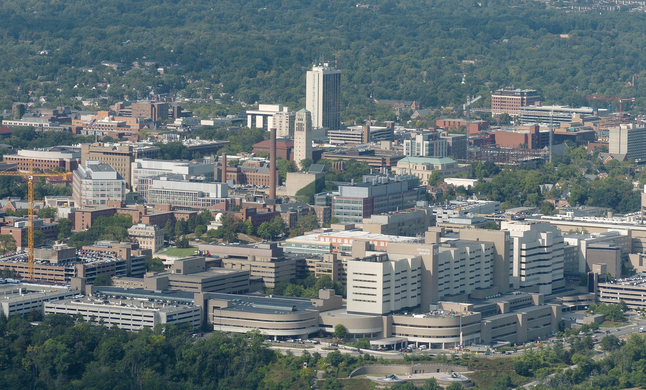
University of Michigan
The projects will cost a combined $69.4 million and are expected to provide an average of 137 construction jobs, according to U-M estimates.
The proposed projects would take place below the streets of Ann Arbor in utility tunnels, in one of U-M's most historic buildings and throughout one of the city's most iconic —and largest— structures.
Regents will discuss the projects during a 3 p.m. Thursday meeting at the Michigan Union.
$23.3 million School of Music, Theater and Dance upgrade and renaming
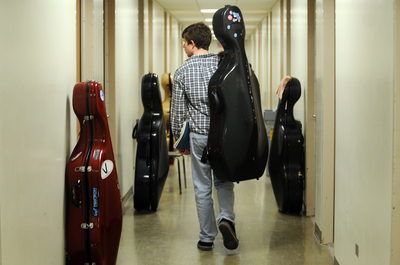
Michigan student Matt Armbruster, of Washington D.C., looks for an empty practice room as he carries his cello down the hall at the Earl V. Moore Building.
Melanie Maxwell I AnnArbor.com
U-M President Mary Sue Coleman announced a $23.3 million renovation and addition to the Earl V. Moore Building, which houses the music school, during her annual leadership breakfast in October.
The college's current infrastructure is outdated and the practice rooms are cramped. Although the school enrolls more than 1,150 students, there are just 50 practice rooms open to all.
The project will include a 21,000-square-foot addition with new rehearsal rooms, classrooms, studios and a lecture hall, as well as improved space for one-on-one time between faculty and students.
The second floor will undergo a reconfiguration to increase the number and quality of current practice rooms.
"I know the students from music, theater and dance will agree when I say this project is overdue," Coleman said in October.
The project partially will be funded by longtime Michigan donors William and Delores Brehm, who are giving $8 million toward the renovation and expansion. U-M will contribute $14 million toward the renovation and seek another $1 million in donor support.
Officials are proposing that the addition be named the 'Brehm Pavilion' due to the $8 million donation.
The Brehms have donated more than $60 million to U-M, helping to fund professorships, scholarships, an addition to the Kellogg Eye Center named Brehm Tower and the Brehm Center for Diabetes Research & Analysis.
U-M has tapped Integrated Design Solutions to design the project, which is expected to provide an average of 29 construction jobs.
$17.5 million renovation to North Campus Research Complex building 20
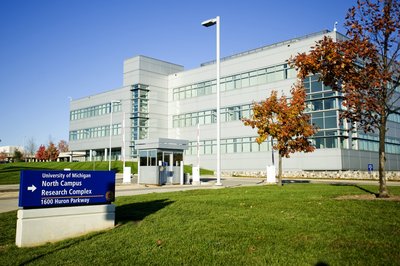
Building renovations continue at North Campus Research Complex.
Joseph Tobianski I AnnArbor.com
U-M purchased the 28-building, 174-acre NCRC in the summer of 2009 for $108 million, a price many considered low. Since the purchase, the university has put nearly $92 million in additional investments into NCRC and officials plan to begin another $17.5 million project next year.
Roughly 68,000 gross square feet of the 1960s-era 'Building 20' will be renovated for use by the medical school.
"Systems will be brought up to contemporary standards for interdisciplinary biomedical research," U-M CFO Timothy Slottow wrote in a memo to regents.
The renovation will update infrastructure and labs. U-M has picked SmithGroupJJR to design the project, which will be finished by winter 2014.
The project is expected to provide an average of 40 construction jobs.
$16.8 million William L. Clements Library upgrade
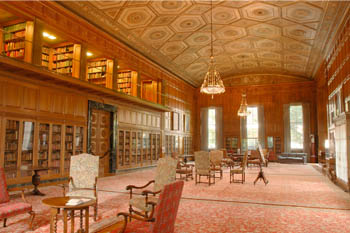
The exhibition hall at the William L. Clements Library.
U-M Photo
Officials are proposing a renovation and 8,500-square-foot addition to the nearly 90-year-old building that houses the William L. Clements Library, an anthology of early American history.
"Many of the building's systems have reached the end of their useful life, and we now propose a comprehensive renovation that will update the building infrastructure in a manner that utilizes historic preservation techniques," Slottow wrote in a memo to regents.
The project includes infrastructure updates and accessibility improvements, as well as the addition, which will house portions of the library's collection and mechanical equipment.
The building is located on central campus and the impact to parking is unclear. The project is expected to provide 31 construction jobs. SmithGroupJJR will design the upgrade.
$6 million Michigan Stadium paint job
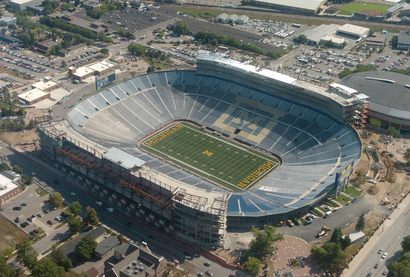
Michigan Stadium
U-M athletic director Dave Brandon is proposing a comprehensive paint job for Michigan Stadium which, if approved, would begin in February and cost $6 million.
Contractors will remove existing paint from the stadium bowl —some of which is lead-based— and repaint the bowl with corrosion-resistant paint. Corroded steel will be replaced or repaired and repainted.
The athletic department will pay for the project, which is expected to provide about 15 on-site construction jobs and isn't expected to affect area parking.
The work is set to be completed in summer 2014, according to an internal memo from Brandon and Slottow.
$3.2 million central campus-area utility tunnel replacement

Road closure during utility tunnel improvement in 2011.
Angela J. Cesere | AnnArbor.com
Below the lush, manicured lawn of U-M's Ann Arbor campus sits roughly 7 miles of utility tunnels- much of which will need improvements during the next decade.
The tunnel network funnels utilities from the Central Power Plant to most central campus buildings.
The university conducted a comprehensive review of the tunnel system in 1998, with updates in 2006 and 2011, and established at least five priority projects. This $3.2 million phase is one of five tunnel projects included in a 10-year capital plan for U-M's utility system.
"Over time, these tunnels and piping systems deteriorate, especially sections located below paved roads," Slottow wrote in a memo to regents.
The proposed project includes replacing sections of concrete tunnel along South University Avenue and replacing portions of steam and condensate lines. The cost also covers landscape repairs needed due to the project.
U-M has chosen engineering firm Fishbeck, Thompson, Carr & Huber Inc. to design the project, which is expected to roughly provide 13 on-site jobs.
Construction is set to finish next fall.
$2.6 million College of Pharmacy renovation
Officials are proposing renovations to 12,000 gross square feet of first floor and basement of the pharmacy building.
The project will reconfigure work space to create smaller offices and add cubicles, allowing for a new lobby space.
U-M has tapped SHW Group to design the project, which is expected to provide nine construction jobs.
Kellie Woodhouse covers higher education for AnnArbor.com. Reach her at kelliewoodhouse@annarbor.com or 734-623-4602 and follow her on twitter.


Comments
Sam Smith
Wed, Nov 14, 2012 : 2:10 p.m.
Many thanks for those that donate funds and make construction and improvement at the U of M. I just wish some money would be funded to keep tuitions lowers so more kids can attend college.
macjont
Wed, Nov 14, 2012 : 1:37 p.m.
U of. M's orphan? The Ed School!
DJBudSonic
Wed, Nov 14, 2012 : 2:52 p.m.
That is the truth. But I heard that UM has a list of all the buildings that need renovation and School of Ed is not in the top 20. They have been doing some improvements over there, with the rennovation of the Brandon Center and Teaching Works spaces, though the building as a whole is pretty outdated.
Ashley Zimmerman
Tue, Nov 13, 2012 : 10:56 p.m.
woo hoo
Stephen Landes
Tue, Nov 13, 2012 : 8:53 p.m.
I would point to two numbers in this article: $16.8 million and $69.4 million. The U plans to spend $16.8 million to refurbish the Clements Library, including all new utilities, in a historically significant building AND to add 8,500 square feet of space. The Clements opened in 1923 which, if memory serves, was long before the internet, WI-FI, and modern heat/vent/AC systems. Somehow that building can be renovated when our AADL can't figure out how to do the same with the Downtown Library. The total spending for all of this work is only $4.8 million more than the AADL wanted to demolish and build a new library downtown. One of these groups needs to sharpen their thinking and their pencils; it isn't the U.
PlateSpinner
Fri, Nov 16, 2012 : 1:47 p.m.
Peter, *It's a small rare-book and manuscript repository.* The Clements is small because it is bursting at the seams. It was initially intended for "a few serious scholars per year" (I'm paraphrasing William Clements himself). It doesn't require a ton of space to house a few scholars. Have you seen the Clements Great Room or just used the Reading Room (or neither)? I am making an assumption that you've actually stepped foot in the building instead of culled information from elsewhere. The architecture is unique and must be preserved. The AADL renovations would not entail preserving any historically significant architectural details. You can put any modern building there that has the technological upgrades and meeting spaces and it would suit the needs of the public. Modern materials are cheap. The Clements is a landmark building designed by Albert Kahn. The electrical systems are woefully antiquated and were not designed to sustain the amount of technology necessary to function today. The renovators will have to preserve the craftsmanship of the original building while making the technology seamless and invisible. Craftsmanship is NOT cheap, so THAT'S where the money comes into play. I suppose AADL would be a bargain to you if you're looking solely at functionality and usage and not the craftsmanship that went into building the Clements. The University tends to like to keep its ambiance intact (like the massive renovation of the fraternity that burned down on Hill - another Kahn building).
Peter Baker
Wed, Nov 14, 2012 : 12:08 a.m.
Stephen, the Clements library is far less than 1/4 of the size of the downtown library, yet the refurbishment will cost more than 1/4 of what the new library building would have. By comparing these two projects, it's reasonable to assume the 90% quoted price of refurbishing the downtown library versus building new would be accurate. So sure, the AADL could rehab and expand on the current building, and spend almost as much as building newer and bigger, like they said. This UofM project only reenforces that.
Stephen Landes
Tue, Nov 13, 2012 : 10:48 p.m.
I volunteer at the Clements (so goes full disclosure). The point is that it is entirely possible to renovate a pre-internet building with outdated utilities in an architecturally significant building including handling incredibly rare and valuable materials (which still need to be available for researchers during construction) and do so for a very reasonable amount.
Peter Baker
Tue, Nov 13, 2012 : 10:43 p.m.
Have you been to the Clements Library? It's a small rare-book and manuscript repository. The Clements Library is visited by 450 researchers yearly. The downtown AADL library is visited by over 600,000 yearly. $17m to refurbish and add 8500sq ft $65m to build 160,000sq ft. I think the AADL project actually looks like a bargain next to that.
JRW
Tue, Nov 13, 2012 : 5:51 p.m.
Here'a an idea for the School of Music: If you don't have enough practice rooms for the students, then don't accept so many students! Only enroll the number of students you have adequate space for! Get real. Not every department has to expand and expand and expand. What's the point? It's a bait and switch to admit more students than you have adequate space for.
A2Insider
Tue, Nov 13, 2012 : 3:31 p.m.
I do think readers of AnnArbor.Com would benefit from fully understanding the businesses that the University of Michigan participates in and the how the resources flow. It seems that many associate one activity and investment as fungible with another and are not aware of the connections. Few probably realize that educating students and the revenue associated with that represents only a third of the institutions total revenue, research represents another ~25% and the reminder is associated with the hospital and clinical operations. People also seem to forget that the reason Ann Arbor is what it is, and not another Flint, Jackson, etc. is because of the activity the University brings into the community. This is first and foremost driven by the reputation of the insitution across the board. A loss of reputation in anyone area begins to affect the others in a vicious cycle. The top researchers no longer want to locate to the institution, the best students go elsewhere, the best faculty who want to teach the best students go elsewhere, the research the supports innovation declines, the hospital begins to lose access to new and innovative practices that once would have been developed at UM, but now are developed elsewhere, etc.. Maintaining a reputation requires on going investment in areas that a traditional investment would not consider a good ROI, but together in the system at a globally leading institution are critical to the overall perception of that institution. Imagine what the community would be in UM slowly deteriorated into a mid-tier institution. It stopped doing the activities that do not relate directly to education and focused only on cutting the organization back to just teach. You now have2/3 of the your building vacant (remember there is no more research or healthcare), an institution no different the dozen plus other teaching institutions in the state, and a local economy (and some would say state economy) severely impacted.
cinnabar7071
Tue, Nov 13, 2012 : 5:27 p.m.
A2Insider just think of what the auto industry would do for Flint, or Detroit if they were taxed at the same level as the U of M.
GoNavy
Tue, Nov 13, 2012 : 4:15 p.m.
"Maintaining a reputation requires on going investment in areas that a traditional investment would not consider a good ROI, but together in the system at a globally leading institution are critical to the overall perception of that institution. " A proper ROI examination takes into account the factors you've mentioned to the extent possible. If you're suggesting that we incorporate measures which cannot be estimated, then I would question the metric. Keep in mind that often managers approve projects which destroy value (in other words, have a negative net present value) because they do not want to see their budget cuts in subsequent years. In other words, if a manager has a $10M budget, his incentive is to use all $10M so that next year's budget is $10m (or more), even if the projects he's investing in provide a poor ROI. Otherwise, if that manager fails to spend the entire budget, his subsequent budget allocation has the potential of being cut.
GoNavy
Tue, Nov 13, 2012 : 1:58 p.m.
Where's the questioning eye here? Where's the investigative journalism? Day after day we read stories of the cost of a Michigan degree reaching levels that are becoming unreachable for increasing numbers of residents of this state. Yet when the University announces this sort of new construction, we praise it for its "ability to provide an average of 137 construction jobs." Come on, AnnArbor.com. Let's get some critical investigative journalism going here - for example, the School of Music had "only 50 practice rooms available to all." Is that below average, average, or above average? What alternatives existed for those students, and were those alternatives sufficient to avoid spending $23.3 million on new upgrades/renovations/additions? We don't even know how much money the School of Music brings in - are these costs being subsidized by other, more profitable or more applicable colleges within the University? Come on, AnnArbor.com - I can get "information" from any source - especially self-praise news releases from the University patting itself on the back for building more, newer, bigger, flashier "stuff." I come to this site for news - not information releases.
Jojo B
Tue, Nov 13, 2012 : 9:48 p.m.
There weren't enough School of Music practice rooms twenty years ago. They were cramped and always stuffed with people and many more waiting outside. Imagine paying big money for a music education and you can't even find a place to practice. The whole building was old and outdated way back then. This is long, long overdue.
Kellie Woodhouse
Tue, Nov 13, 2012 : 2:16 p.m.
Here's an in-depth piece I wrote in January on the music school facility. I think you'll find the answers to many of your questions here. Also, always feel free to contact me directly (kelliewoodhouse@annarbor.com) with story ideas that interest you. http://www.annarbor.com/news/education/university-of-michigan-music-school-seeks-funding-for-facility-improvement/
A Voice of Reason
Tue, Nov 13, 2012 : 1:55 p.m.
I say, forget the building and give the money to the students. Give every freshman a cut of the money and that would be $13,800 each. I think the University has forgotten its' mission. Oh of course buildings need renovation. Does the stadium really need to be painted? Give every student that money (13,000,000/40,000) that is $325 each. What a wasteful group of people that run the U.
Evan Smith
Tue, Nov 13, 2012 : 8:44 p.m.
Much of the current paint in the stadium is lead based. The School of Music, Theater and Dance is ridiculously over capacity. The William L. Clements Library is 90 years old. The central campus-area utility tunnel is degraded, and getting worse. The NCRC is used for research that benefits everyone. Frankly, the costs to fix these problems seem more than justified to me. I feel like you don't realize that buildings need functioning infrastructure and periodic renovations to maintain efficiency. Your argument is ridiculous.
clownfish
Tue, Nov 13, 2012 : 1:22 p.m.
Government does not create jobs. Repeat, rinse. Unless Mitt would have been elected, then government would have created 12 million jobs, because Mitt is the Anti-GOP Talking Point.
jon67
Tue, Nov 13, 2012 : 4:13 p.m.
This sentence is unintelligible. Just what is it you're trying to say?
Salbolal
Tue, Nov 13, 2012 : 12:54 p.m.
$58 million. Good thing they didn't have to pass a proposal through the voters.